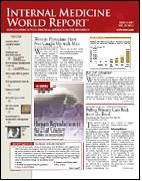Masked Hypertension
Masked Hypertension
The “white-coat” effect is a common occurrence in medical practice—patients come for an office visit and have elevated blood pressure (BP) readings while in the health care setting. Their physician may then order ambulatory BP monitoring, to verify the diagnosis of hypertension, at which point the patient has normotensive reading.
Results of a recent study not only confirm the existence of white coat hypertension but have also established the phenomenon of masked hypertension—readings of normal BP in the office versus high BP at home.
Study Results
The SHEAF (Self-Measurement of Blood Pressure At Home in the Elderly: Assessment and Follow-up) [JAMA. 2004:291:1342-1349]) study assessed the prognostic value of home versus office BP readings in a European population of older adults being treated for hypertension by their general physician. A total of 4949 patients, mean age 70, were recruited by their physicians. In the first phase of the trial, these patients had 2 separate office visits at 2-week intervals. Both office and home BP readings were recorded, as well as treatment agents and medical and demographic histories. The 3-year follow-up period was observational, with no specific management recommendations.
Uncontrolled hypertension was defined as 140/90 mm Hg for office BP measurement and 135/85 mm Hg for home. The primary end point was cardiovascular (CV) mortality and secondary end points were total mortality and the combination of CV mortality, nonfatal myocardial infarction, nonfatal stroke, transient ischemic attack, hospitalization for angina or heart failure, percutaneous transluminal coronary angioplasty, or coronary artery bypass graft surgery.
Home and Office Measurements
For the first 2 office visits, BP measurements were taken in triplicate, using a mercury sphygmomanometer. The patient was resting, seated for 5 minutes before measuring BP. The measurements at home were planned over a 4-day period and 3 were taken in the morning (8 am) and 3 in the evening (8 pm). The Omron-705 CP device, quipped with a printer, was used. Patients recorded their readings and attached their printouts as well, to avoid possible recording errors.
At baseline, 13,9% showed BP control at home and office, 13.3% had elevated BP in the office only, 9.4% had elevated readings at home only, and 63.4% had uncontrolled hypertension at the office and at home.
At the end of follow-up, for BP self-measurement at home, each 10-mm Hg elevation in systolic BP increased the risk of CV events by 17.2%, and each 5-mm Hg elevation in diastolic BP increased risk by 11.7%.
For the same increase in BP observed in office measurements, there was no significant increase in risk of CV events.
Guillaume Bobrie, MD, noted that the SHEAF study suggests that home BP measurement has better prognostic accuracy than office measurements, and for patients receiving treatment for hypertension, BP must be measured at home as well. Office BP measurements failed to identify 13% of patients with elevated BP in the office and not at home with a good prognosis and 9% of those with elevated BP at home and not in the office who had a poor prognosis, he added.
